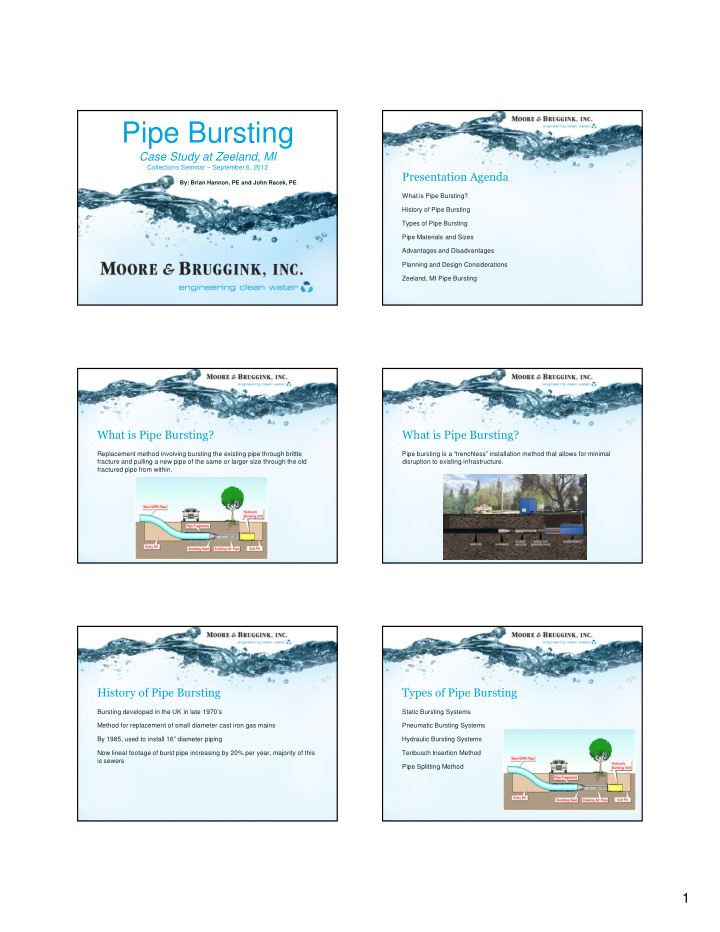



Pipe Bursting Case Study at Zeeland, MI Collections Seminar – September 6, 2012 ������������������� By: Brian Hannon, PE and John Racek, PE What is Pipe Bursting? History of Pipe Bursting Types of Pipe Bursting Pipe Materials and Sizes Advantages and Disadvantages Planning and Design Considerations Zeeland, MI Pipe Bursting ���������������������� ���������������������� Replacement method involving bursting the existing pipe through brittle Pipe bursting is a “trenchless” installation method that allows for minimal fracture and pulling a new pipe of the same or larger size through the old disruption to existing infrastructure. fractured pipe from within. ������������������������ ���������������������� Bursting developed in the UK in late 1970’s Static Bursting Systems Method for replacement of small diameter cast iron gas mains Pneumatic Bursting Systems By 1985, used to install 16” diameter piping Hydraulic Bursting Systems Now lineal footage of burst pipe increasing by 20% per year, majority of this Tenbusch Insertion Method is sewers Pipe Splitting Method 1
���������������������� ���������������������� Static Bursting Systems Static Bursting Systems Pneumatic Bursting Systems Pneumatic Bursting Systems Hydraulic Bursting Systems Hydraulic Bursting Systems Tenbusch Insertion Method Tenbusch Insertion Method Pipe Splitting Method Pipe Splitting Method ���������������������� ���������������������� Static Bursting Systems Static Bursting Systems Pneumatic Bursting Systems Pneumatic Bursting Systems Hydraulic Bursting Systems Hydraulic Bursting Systems Tenbusch Insertion Method Tenbusch Insertion Method Pipe Splitting Method Pipe Splitting Method ���������������������������� ���������������������������� Standard Cone Shaped Head Pneumatic Head 2
���������������������������� ���������������������������� Splitting Head Expanding Cone Head (cutting wheel or knives) ������������������� ��������������������������� What types of pipe materials can be burst? Type of Existing Pipe CI, DI, VCP, AC, RCP, PVC, HDPE, Copper, etc. Type of Soils What types of pipe materials can be installed? Type of New Pipe HDPE, PVC, DI, VCP, RCP TABLE 2.1 from ASCE MOP 112 What are the minimum and maximum sizes that can be burst? Discuss with Contractors Pipe bursting has been successfully completed on 4”-36” piping. How large can you make the new pipe? New pipe can be upsized 2-3 sizes depending on soil conditions, new pipe material, and depth. ���������� ������������� No trenching involved means minimal disruption of existing infrastructure. Must dig up lateral locations Pipe size can be increased along the same route. Cannot change slope of line Can be more cost effective given project conditions. Bypass Pumping is usually necessary Faster installation than open cut, especially for deep pipe. Cannot burst through valves Minimal dewatering necessary in wet conditions. Repair sleeves or encasements may be difficult or impossible to burst Minimizes social costs such as traffic diversions, etc. If HDPE or welded PVC is pulled through, need room for long run of pipe If heaving occurs, may need some surface restoration 3
���������������������������������� �������� ����������������� Soil Types and Conditions and Groundwater Depths Background: Existing Pipe Material and New Pipe Material Business Growth Created Need for Increased Pipe Size, Larger Pump station Surface Heaving Project: Utility Locations and Connection Points Increase 700 LFt of VC gravity sewer from 8” to 12” by pipe burst Televise Existing Pipeline Increase pump station capacity Pit Locations and Pipe Layout Locations Increase forcemain size from 6” to 10” by open cut Cost Considerations (including Social) ������������������������� ������������������������� Utilities over the existing deep sewer pipe Utilities over the existing deep sewer pipe • Water • Water • Electrical (4) • Electrical (4) • Storm Sewer • Storm Sewer • Gas • Gas • Sidewalk • Sidewalk • Parking Lots • Parking Lots • Storm Pond • Storm Pond • Fiber Optic Cable • Fiber Optic Cable ������������������������� !"�������#������������������ $�����%�����&����� Pipe type conditions were favorable Deep pipe would have had large dewatering costs Minimal laterals to connect Distance (700 ft) favorable for single pull Directly outside of business parking lot Prevent Dewatering of Decorative Stormwater Pond Surface heave not a problem in this case 4
!"������������������������ ���������'�����(�$����"���'������� ������������������������������� �������������������)������������ ���������������������������)�� ������������������ �)����������� Capacity = 300 ton 5
����������#�����������������)�� �������������������*��� �������������������� !"��������������������+������������ *���������������� !"������������� &���������&�������!������*��,��+��,��*-. �������������%/�!"������ 6
��������������%/� ���������������������������!"����������� ������'���������� ���)������� ������������� &�����������0����� 3�%��������� ������������ ���������� �"�������10����2� !������� ���� ����������������������!"����������� *�'������������������������4����� 7
���������������������������� ��������!������ ������������������ !������������ !�������������������+������������ �������������������1����5�������2�������� ���������������������������������������� ��������� !�������������� ����������'�3�%� ����������� ����������� 8
3�%��������������������������������� 3�%��������� �������������� �����������&������������!������������ 9
ERROR: undefined OFFENDING COMMAND: f‘ STACK:
Recommend
More recommend